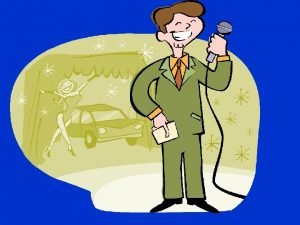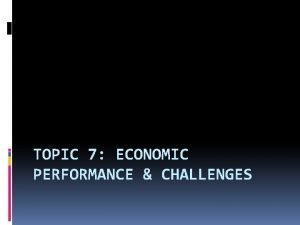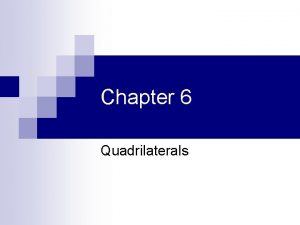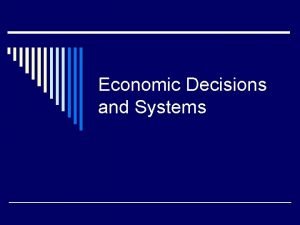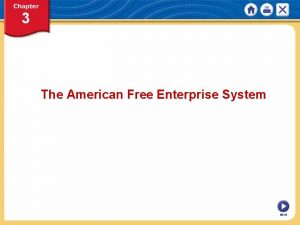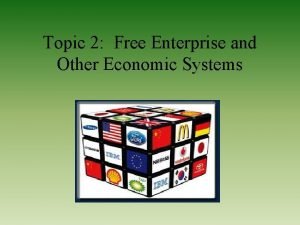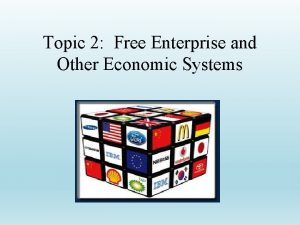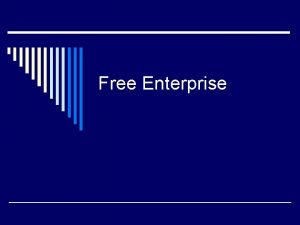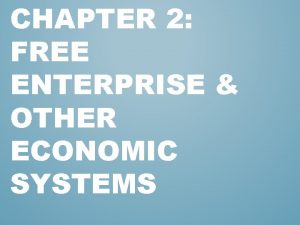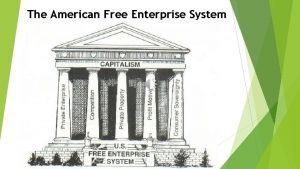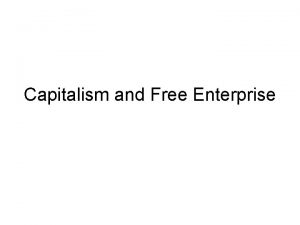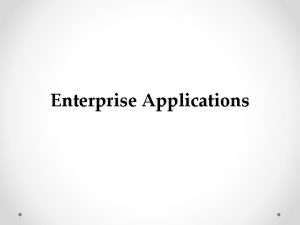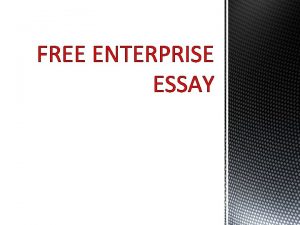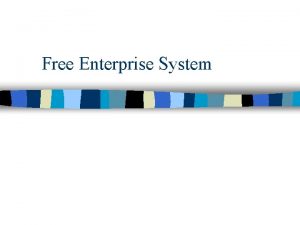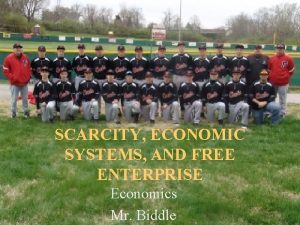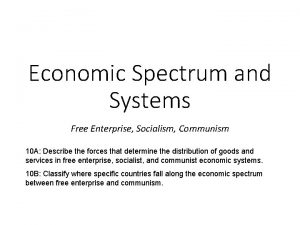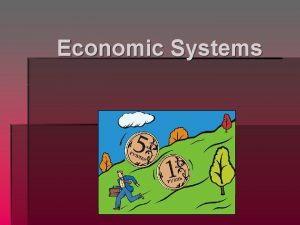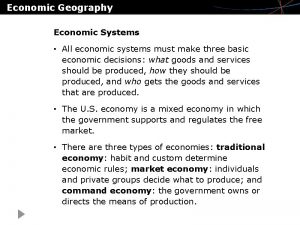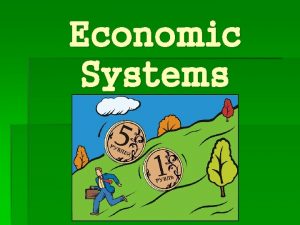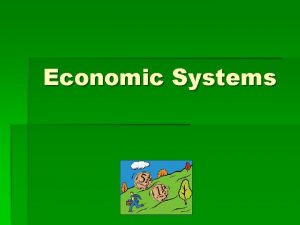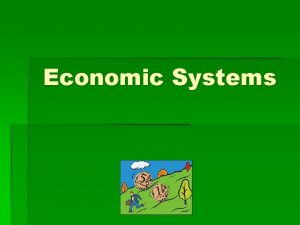Topic 2 Free Enterprise and Other Economic Systems
























- Slides: 24

Topic 2: Free Enterprise and Other Economic Systems

Topic Objectives Students will be able to • • • Identify the three basic economic questions that all societies must answer Describe the economic goals that determine how a society answers the three economic questions. Define the characteristics of a traditional society. Explain why markets exist. Explain a circular flow model of a free market economy. Describe how self-interest and competition lead to the self-regulating nature of the marketplace. Identify the advantages of a free market economy. Describe how a centrally planned economy is organized, including its disadvantages. Distinguish b/w socialism and communism. Explain the rise of mixed economic systems. Explain the basic characteristics of the US free enterprise system. Describe the role of government in the US free enterprise system.

I. The Three Basic Economic Questions • Because resources are scarce, every society must answer three economic questions: • What goods/services should be produced? • How should these goods/services be produced? • Who consumes these goods/services? • The way a society answers these questions defines its economic system.

Three Questions… 1. What Goods/ Services to Be Produced? * Every society must decide what to produce to satisfy needs/wants * Ex: food, shelter, consumer goods. * Each decision comes w/ opportunity costs 2. How Should Goods and Services Be Produced? * Ex: What fuel use? Oil, solar, nuclear? * Figure 2. 1 * All decisions involve trade-offs

Three Questions… 3. Who Consumes the Goods and Services that are produced? * Answers to questions are largely determined by how societies distribute income. * Factor Payments * Profit

I. Three Questions… Economic Goals of Society 1. Efficiency 2. Freedom 3. Security… safety net 4. Equity… Figure 2. 2 5. Growth… Standard of Living, Innovation 6. Conflicting Economic Goals ***Traditional Economies Which basic economic goals can be achieved easily in a traditional economy? Which cannot?

II. Free Markets Why Do Markets Exist? 1. Define: Markets * Markets eliminate the need for self-sufficient 2. Role of Specialization * Leads to efficiency in the use of capital, land, and labor; benefits businesses and specialists 3. Buying and Selling * Need a mechanism that allows buying/selling that was produced and buy what they want.

II. Free Markets Elements of a free Market Economy • Answers to the 3 ? s are made by voluntary exchange in markets. • Individuals and businesses make their own decisions about what to buy or sell. • Mkt Eco: sometimes called capitalist economies b/c the capital that entrepreneurs invest is a vital part of system. • Role of Households/ Firms: Own f of p & Consume g/s • Role of Factor & Product Markets – FM: firms purchase f of p from households – PM: Household buy g/s that firms produce

II. Free Markets How Markets Self-Regulate • Self Interest & Adam Smith/ The Wealth of Nations • Incentives (Motivate) & Competition (Regulates) Figure 2. 5 • The Invisible Hand: No central planning or direction – Supply/Demand; Individual Incentives What does competition among producers in a free market accomplish for consumers?

II. Free Markets Advantages of a Free Market 1. Economic Efficiency: Respond to Mkt Conditions 2. Economic Freedom: Choice: Consumers & Producers 3. Economic Growth: S of Living & Innovation Note: Figure 2. 6 Consumer Sovereignty

III. Centrally Planned Economies Features of Central Planning • Also: Command Economy • Def: Govt answers 3 ? s; owns land, capital, even labor • Contrast to a free market system • No free mkt forces of self-interest, incentives, and competition. • No: private property, free mkt pricing, competition, consumer sovereignty • Examples: Communism & Socialism • How is the gun v. butter debate resolved?

III. Centrally Planned Economies Socialism • Range of eco systems/ practices • Allows ownership of some private property • Can be part of democratic system Communism • Requires revolutionary change: Eco Equity requires central authority • Govt is authoritarian, not democratic • State ownership of f of prod

III. Centrally Planned Eco: Socialism v. Communism • Both: even distribution of wealth and centralized control of economic power. • Socialist Countries May be Democratic, but communism always authoritarian… limit individual freedom and require strict obedience • Note: Karl Marx – Worker Exploitation, Unfair Wealth Distribution What belief did Karl Marx hold about capitalism? Figure 2. 8: Production Goals: Soviet 5 Year Plan

III. Centrally Planned Economies Disadvantages of Central Planning 1. 2. 3. 4. 5. Economic Inefficiency: No incentive, huge bureaucracy Lack of Economic Freedom: Society over Individual Lack of Economic Growth: Innovation Discouraged Economic Inequity: Eq of Results rarely achieved Positives: Jobs, Women, Healthcare, New industries Why do centrally planned economies tend not to be efficient? Who benefits and who suffers most from a centrally planned economy? How?

IV. Mixed Economies I. The Reasons for a Mixed Economy A. Why Govt Gets Involved 1. Public Needs: Infrastructure, Education 2. Equity: Ex: Child Labor, Equal Pay 3. Protect Property Rights: Physical, Intellectual 4. Ensure Fair Exchanges (contracts) 5. Redistribution of Wealth: 16 th A, Mini Wage, SS B. Balancing Govt and Eco Freedom *History…. Role of Policymaking

IV. Mixed Economies II. Circular Flow Model of a Mixed Economy: shows how govt interacts w/ households and businesses

IV. Mixed Economies… Circular Flow 1. 2. 3. Govt Actions in FM: purchase land, labor, capital Govt Actions in PM: purchase goods, services Govt Transferring Money: SS, Medicare, Unem, Food Stamps, Vet Benefits

IV. Mixed Economies C. Mixed Economies Today 1. Mixed Eco w/ Heavy Govt Involvement 2. Mixed Eco Tending Toward Free Markets 3. Role of Govt *Keep order, Provide services, Promote welfare, Protect private property, Some regulations/limitations 4. Overall Economic Freedom: Choices for Consumers/Producers 5. Transition Towards Privatization Can be Difficult Note: Continuum on Mixed Economies: Figure 2. 12

V. Benefits of Free Enterprise A. Basic Characteristics of Free Enterprise 1. Opportunity: Individual 2. Incentives: Self interest: wages, profits, prices 3. Profit Motive: encourages risk, innovation 4. Competition; Open Opportunity: anyone can compete; regulates the market 5. Legal Equality 6. Private Property Rights: Control, Preserve, Protect 7. Economic Freedom: Free Contract, Voluntary Exchange

V. Benefits of Free Enterprise B. Key Roles in the Free Enterprise System 1. Role of the Consumer * Sends Signal… Interest Group Involvement 2. Role of the Entrepreneur * Decides on Resources, Makes Profit C. Economic Freedom and the Constitution 1. Property Rights: Eminent Domain; 5 th A 2. Taxation: 16 th A 3. Contracts

V. Benefits D. Limited Role of Govt in the Marketplace ** Constitutional responsibility to protect property rights evolved into actions to promote the public interest. 1. Information & Free Enterprise *Public Disclosure Laws; Truth-in-Lending Laws 2. Protecting Public Health, Safety, and Well-being *EPA, OSHA 3. Negative Effects of Regulation * Rules can be costly to implement: slow eco growth & cut into profit * Stifle competition and raise prices (ex: tariffs) * Increase govt spending, bureaucracy: enforce

Major Regulatory Agencies • • • Food and Drug Administration Federal Reserve System Federal Deposit Insurance Corporation Federal Aviation Administration Environmental Protection Administration Occupational Safety & Health Administration Consumer Protection Safety Commission Nuclear Regulatory Commission Transportation Security Administration Consumer Financial Protection Bureau – Page 49

Important Terms Macroeconomics: study of economic behavior and decisionmaking in a nation’s whole economy. Microeconomics: study of economic behavior and decision making in small units (households, firms) Gross Domestic Product: total value of all final goods and services produced annually in a country. Business Cycle: the alternating pattern of periodic expansion and contraction (Figure 2. 6) Public Good: shared good or service (infrastructure); financed by the public sector.

Enduring Objectives • Because societies answer the key economic questions differently, multiple economic systems have developed. • Competition helps to regulate markets and gives producers incentives to make what consumers want. • Because pure market and pure centrally planned economies have drawbacks, nations tend to have mixed economies. • Under the American free enterprise system, the government preserves economic freedoms while protecting the public interest through limited regulation of the economy.
 Free enterprise system def
Free enterprise system def Economics unit 1 lesson 2 difficult choices
Economics unit 1 lesson 2 difficult choices Business cycles occur in free enterprise systems because
Business cycles occur in free enterprise systems because Example of clincher sentence
Example of clincher sentence Narrowed down topic
Narrowed down topic Topic 7 economic performance and challenges
Topic 7 economic performance and challenges Topic 6 quadrilaterals and other polygons answers
Topic 6 quadrilaterals and other polygons answers Topic 6 quadrilaterals and other polygons answers
Topic 6 quadrilaterals and other polygons answers What is economic growth and development
What is economic growth and development Putting the enterprise into the enterprise system
Putting the enterprise into the enterprise system Enterprise
Enterprise Economic growth vs economic development
Economic growth vs economic development Chapter 2 economic systems and decision making answer key
Chapter 2 economic systems and decision making answer key Chapter 2 economic systems and decision making
Chapter 2 economic systems and decision making Chapter 2 economic systems and decision making answer key
Chapter 2 economic systems and decision making answer key Chapter 1 economic decisions and systems answer key
Chapter 1 economic decisions and systems answer key Comparative systems worksheet answer key
Comparative systems worksheet answer key Free time activities dialogue
Free time activities dialogue In my free time i like to watch movies
In my free time i like to watch movies Examtopic
Examtopic Helmholtz free energy and gibbs free energy
Helmholtz free energy and gibbs free energy Summary of the story of an hour
Summary of the story of an hour Happy isles ulysses
Happy isles ulysses Self initiated other repair
Self initiated other repair Modified free enterprise economy
Modified free enterprise economy


